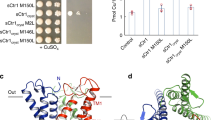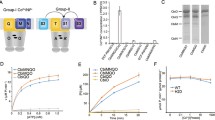Abstract
It was shown recently, that high affinity Cu(I) importer eukaryotic protein CTR1 can also transport in vitro abiogenic Ag(I) ions and anticancer drug cisplatin. At present, there is no rational explanation how CTR1 can transfer platinum group which is different by coordination properties from highly similar Cu(I) and Ag(I). To understand the phenomenon, we analyzed 25 sequences of chordate CTR1 proteins and found out the conserved patterns of organization of N-terminal extracellular part of CTR1 which is responsible for initial metal binding. Extracellular copper-binding motifs were qualified by their coordination properties. It was shown that the relative position of methionine- and histidine-rich copper-binding motifs predisposes the extracellular CTR1 region to binding of copper, silver, and cisplatin. Relation between the tissuespecific expression of the CTR1 gene, steady-state copper concentration, and silver and platinum accumulation in organs of mice in vivo were analyzed. Significant positive yet incomplete correlation was found to exist between these variables. Basing on structural and functional peculiarities of N-terminal part of CTR1 a hypothesis of coupled transport of copper and cisplatin has been suggested which avoids disagreement between CTR1-mediated cisplatin transport in vitro and irreversible binding of platinum to Met-rich peptides.
Similar content being viewed by others
Abbreviations
- PC:
-
principal component
- TMD:
-
transmembrane domain
References
Karlin K.D. 1993. Metalloenzymes, structural motif, and inorganic models. Science. 261, 701–717.
Rosenzweig A.C., Sazinsky M.H. 2006. Structural insights into dioxygen-activating copper enzymes. Curr. Opin. Struct. Biol. 16, 729–735.
Madsen E., Gitlin J.D. 2007. Copper and iron disorders of the brain. Annu. Rev. Neurosci. 30, 317–337.
Mufti A.R., Burstein E., Duckett C.S. 2007. XIAP: Cell death regulation meets copper homeostasis. Arch. Biochem. Biophys. 463, 168–174.
Martin F., Linden T., Katschinski D.M. 2005. Copperdependent activation of hypoxia-inducible factor (HIF)-1: Implications for ceruloplasmin regulation. Blood. 105, 4613–4619.
Gaggelli E., Kozlowski H., Valensin D., Valensin G. 2006. Copper homeostasis and neurodegenerative disorders (Alzheimer’s, prion, and Parkinson’s diseases and amyotrophic lateral sclerosis). Chem. Rev. 106, 1995–2044.
Aller S., Unger V. 2006. Projection structure of the human copper transporter CTR1 at 6-Å resolution reveals a compact trimer with a novel channel-like architecture. Proc. Natl. Acad. Sci. U. S. A. 103, 3627–3632.
Samsonov S.A., Platonova N.A., Skvortsov A.N., Tsymbalenko N.V., Vasin A.V., Puchkova L.V. 2006. Relationships between CTR1 activity and copper status in different rat organs. Mol. Biol. (Moscow). 40, 207–217.
Sharp P. 2003. Ctr1 and its role in body copper homeostasis. Int. J. Biochem. Cell Biol. 35, 288–291.
Lee J., Pena M.M., Nose Y., Thiele D.J. 2002. Biochemical characterization of the human copper transporter Ctr1. J. Biol. Chem. 277, 4380–4387.
Bertinato J., Cheung L., Hoque R., Plouffe L.J. 2010. Ctr1 transports silver into mammalian cells. J. Trace Elem. Med. Biol. 24, 178–184.
Ishida S., Lee J., Thiele D.J., Herskowitz I. 2002. Uptake of the anticancer drug cisplatin mediated by the copper transporter Ctr1 in yeast and mammals. Proc. Natl. acad. Sci. U. S. A. 99, 14298–14302.
Kuo M.T., Chen H.H.W., Song I.S., Savaraj N., Ishikawa T. 2007. The roles of copper transporters in cisplatin resistance. Cancer Metastasis Rev. 26, 71–83.
De Feo C.J., Aller S.G., Siluvai G.S., Blackburn N.J., Unger V.M. 2009. Three-dimensional structure of the human copper transporter hCTR1. Proc. Natl. Acad. Sci. U. S. A. 106, 4237–4242.
Ilyechova E., Skvortsov A., Zatulovsky E., Tsymbalenko N., Shavlovsky M., Broggini M., Puchkova L. 2011. Experimental switching of copper status in laboratory rodents. J. Trace Elem. Med. Biol. 25, 27–35.
Klotchenko S.A., Tsymbalenko N.V., Solov’ev K.V., Skvortsov A.N., Zatulovskii E.A., Babich P.S., Platonova N.A., Shavlovskii M.M., Puchkova L.V., Broggini M. 2008. The effect of silver ions on copper metabolism and expression of genes encoding copper transport proteins in rat liver. Dokl. Biochem. Biophys. 418, 24–27.
Brereton R.G. 2007. Applied Chemometrics for Scientists. Chichester: Wiley.
Engelman D.M., Steitz T.A., Goldman A. 1986. Identifying nonpolar transbilayer helices in amino acid sequences of membrane proteins. Annu. Rev. Biophys. Biophys. Chem. 15, 321–353.
Jones D.T., Taylor W.R., Thornton J.M. 1994. A mutation data matrix for transmembrane proteins. FEBS Lett. 339, 269–275.
Puig S., Lee J., Lau M., Thiele D.J. 2002. Biochemical and genetic analyses of yeast and human high affinity copper transporters suggest a conserved mechanism for copper uptake. J. Biol. Chem. 277, 26021–26030.
Klomp A.E., Juijn J.A., van der Gun L.T., van den Berg I.E., Berger R., Klomp L.W. 2003. The N-terminus of the human copper transporter 1 (hCTR1) is localized extracellularly, and interacts with itself. Biochem. J. 370, 881–889.
Abada P., Howell S.B. 2010. Regulation of cisplatin cytotoxicity by Cu influx transporters. Metal. Based. Drugs. 2010:317581.
van den Berghe P.V., Folmer D.E., Malingré H.E., van Beurden E., Klomp A.E., van de Sluis B., Merkx M., Berger R., Klomp L.W. 2007. Human copper transporter 2 is localized in late endosomes and lysosomes and facilitates cellular copper uptake. Biochem J. 407, 49–59.
De Feo C.J., Mootien S., Unger V.M. 2010. Tryptophan scanning analysis of the membrane domain of CTR-copper transporters. J. Membr. Biol. 234, 113–123.
Gilmore R., Blobel G. 1985. Translocation of secretory proteins across the microsomal membrane occurs through an environment accessible to aqueous perturbants. Cell. 42, 497–505.
Aller S., Eng E., De Feo C., Unger V. 2004. Eukaryotic CTR copper uptake transporters require two faces of the third transmembrane domain for helix packing, oligomerization, and function. J. Biol. Chem. 279, 53435–53441.
Klomp A.E., Tops B.B., van Denberg I.E., Berger R., Klomp L.W. 2002. Biochemical characterization and subcellular localization of human copper transporter 1 (hCTR1). Biochem. J. 364, 497–505.
Guo Y., Smith K., Lee J., Thiele D.J., Petris M.J. 2004. Identification of methionine-rich clusters that regulate copper-stimulated endocytosis of the human Ctr1 copper transporter. J. Biol. Chem. 279, 17428–17433.
Larson C.A., Adams P.L., Jandial D.D., Blair B.G., Safaei R., Howell S.B. 2010. The role of the N-terminus of mammalian copper transporter 1 in the cellular accumulation of cisplatin. Biochem. Pharmacol. 80, 448–454.
Parr R.G., Pearson R.G. 1983. Absolute hardness: Companion parameter to absolute electronegativity. J. Am. Chem. Soc. 105, 7512–7516.
Sarmah P., Deka R.C. 2008. Solvent effect on the reactivity of CIS-platinum(II) complexes: A density functional approach. Int. J. Quantum Chem. 108, 1400–1409.
Shannon R.D. 1976. Revised effective ionic radii and systematic studies of interatomic distances in halides and chalcogenides. Acta Cryst. Sec. A. 32, 751–767.
CRC Handbook of Chemistry and Physics, 86th ed. 2005. Ed. Lide D.R. CRC Press.
Rubino J.T., Riggs-Gelasco P., Franz K.J. 2010. Methionine motifs of copper transport proteins provide general and flexible thioether-only binding sites for Cu(I) and Ag(I). J. Biol. Inorg. Chem. 15, 1033–1049.
Jiang J., Nadas I.A., Kim A.M., Franz K.J. 2005. A mets motif peptide found in copper transport proteins selectively binds Cu(I) with methionine-only coordination. Inorg. Chem. 44, 9787–9794.
Zhang L., Koay M., Maher M.J., Xiao Z., Wedd A.G. 2006. Intermolecular transfer of copper ions from the CopC protein of Pseudomonas syringae: Crystal structures of fully loaded Cu(I)Cu(II) forms. J. Am. Chem. Soc. 128, 5834–5850.
Haas K.L., Putterman A.B., White D.R., Thiele D.J., Franz K.J. 2011. Model peptides provide new insight into the role of histidine residues as potential ligands in human cellular copper acquision via Ctr1. J. Am. Chem. Soc. 133, 4427–4437.
Zhou B., Gitschier J. 1997. hCTR1: A human gene for copper uptake identified by complementation in yeast. Proc. Natl. Acad. Sci. U. S. A. 94, 7481–7486.
Zatulovskiy E., Samsonov S., Skvortsov A. 2007. Docking study on mammalian CTR1 copper importer motifs. BMC Syst. Biol. 1(S1), P54.
Linder M.C. 2001. Copper and genomic stability in mammals. Mutat. Res. 475, 141–152.
Arnesano F., Scintilla S., Natile G. 2007. Interaction between platinum complexes and a methionine motif found in copper transport proteins. Angew. Chem. Int. Ed. Engl. 46, 9062–9064.
Long F., Su C.C., Zimmermann M.T., Boyken S.E., Rajashankar K.R., Jernigan R.L., Yu E.W. 2010. Crystal structures of the CusA efflux pump suggest methionine-mediated metal transport. Nature. 467, 484–488.
Su C.C., Yang F., Long F., et al. 2009. Crystal structure of the membrane fusion protein CusB from Escherichia coli. J. Mol. Biol. 393, 342–355.
Hahn M., Kleine M., Sheldrick W.S. 2001. Interaction of cisplatin with methionine- and histidine-containing peptides: Competition between backbone binding, macrochelation and peptide cleavage. J. Bioinorg. Chem. 6, 556–566.
Reedijk J. 1999. Why does cisplatin reach G-N7 with competing S-donor ligands available in the cell. Chem. Rev. 99, 2499–2510.
Barnham K.J., Djuran M.I., Murdoch P.D.-S. Sadler P.J. 1994. Intermolecular displacement of S-bound L-methionine on platinum (II) by guanosine 5′-monophosphate. Implications for the mechanism of action of anticancer drugs. J. Chem. Soc. Chem. Commun. 721–722.
Dickerson R.E., Eisenberg D., Varnum J., Kopka M.L. 1969. PtCl4 2-: A methionine-specific label for protein crystallography. J. Mol. Biol. 45, 77–84.
Ivanov A.I., Christodoulou J., Parkinson J.A., Barnham K.J., Tucker A., Woodrow J., Sadler P.J. 1998. Cisplatin binding sites on human albumin. J. Biol. Chem. 273, 14721–14730.
Wei M., Cohen S.M., Silverman A.P., Lippard S.J. 2001. Effects of spectator ligands on the specific recognition of intrastrand platinum-DNA cross-links by high mobility group box and TATA-binding proteins. J. Biol. Chem. 276, 38774–38780.
Wilkinson G., Gillard R.D., McCleverty J.A. 1989. Comprehensive Coordination Chemistry: The Synthesis, Reactions, Properties and Applications of Coordination Compounds. Oxford: Pergamon Press.
Sze C.M., Khairallah G.N., Xiao Z., Donnelly P.S., O’Hair R.A., Wedd A.G. 2009. Interaction of cisplatin and analogues with a Met-rich protein site. J. Biol. Inorg. Chem. 14, 163–165.
Cheng C.-C., Pai C.-H. 1998. Specific displacement of glutathione from the Pt(II)-glutathione adduct by Cu(II) in neutral phosphate buffer. J. Inorg. Biochem. 71, 109–113.
Author information
Authors and Affiliations
Corresponding author
Additional information
Original Russian Text © A.N. Skvortsov, E.A. Zatulovskiy, L.V. Puchkova, 2012, published in Molekulyarnaya Biologiya, 2012, Vol. 46, No. 2, pp. 335–347.
Rights and permissions
About this article
Cite this article
Skvortsov, A.N., Zatulovskiy, E.A. & Puchkova, L.V. Structure-functional organization of eukaryotic high-affinity copper importer CTR1 determines its ability to transport copper, silver, and cisplatin. Mol Biol 46, 304–315 (2012). https://doi.org/10.1134/S0026893312010219
Received:
Accepted:
Published:
Issue Date:
DOI: https://doi.org/10.1134/S0026893312010219




